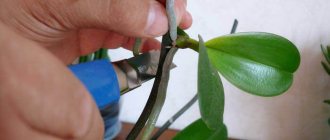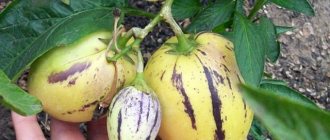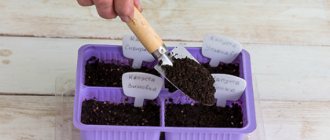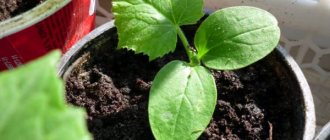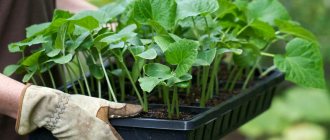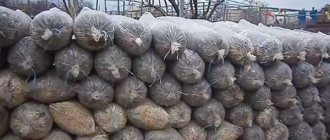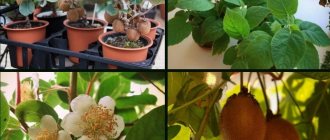Orchids are beautiful flowers that get along well at home next to a person. Since the century before last, there have been many changes in the methods of care and reproduction of these wonderful tropical beauties. Now there is no need for laboratory conditions for the orchid family to reproduce.
Among several methods of home propagation, one is distinguished. To implement it, you need patience and the ability to properly care for an orchid, and gardeners who choose orchids should have plenty of these qualities.
In this article we will talk about transplanting baby orchids at home.
Tools and materials for planting a shoot
In addition to knowledge of how to separate, plant and root a shoot, you will need a number of materials to carry out these procedures. It will also be useful to have a list of necessary tools and knowledge of how to prepare them for work.
You can grow a full-fledged plant from a baby
Materials
Before you take a shoot from an orchid, you need to prepare everything. The list of materials is small:
- Styrofoam. It can be used as drainage, although flower growers have different opinions on this matter. It can also be useful for constructing a kind of floating stand for the appendage.
- Earth. Ordinary garden soil is not suitable as a soil for replanting. The best solution would be to purchase a special substrate for orchids at a garden center.
- Pine bark. The soil for growing orchids always includes this material. The main thing you need to pay attention to is the integrity of the pieces. Crumbs and too small pieces of bark will not work.
- Charcoal. Another component of the substrate, which is necessary not only for regulating humidity, but also for disinfection. In crushed form, this material is used to disinfect cuts on the plant.
- Sphagnum moss. This component can be part of a growing mixture, but more often it is used to stimulate root growth in children and as a cover for the roots of an adult plant.
Important! All components included in the substrate, and the substrate itself, must be of high quality. It is better to give preference to trusted producers and not to replant capricious flowers in poor-quality soil.
Tools
To separate the baby, you will need a sharp knife, which should first be treated with alcohol or another disinfectant. This is the tool that is mainly used, but if others are used in addition, they also need to be processed.
Most often, a plastic transparent glass or pot is used as a container. You can use other containers made of the same material with a lid that are suitable in volume. The most important thing is that they are completely new to prevent the risk of infection of the plant.
When to replant keiki orchids: optimal timing
A baby can be planted from any flower when the length of its roots reaches 5–6 cm. There will be at least 3–4 roots, and it will also have at least 3–5 well-formed leaves.
Thanks to the leaves, the shoot independently breathes and photosynthesizes. There is no point in removing it ahead of time: it will not take root in a separate pot. The main thing here is patience and proper care. Keiki must grow on the mother bush for at least six months. It is best to replant them in spring or summer.
Methods for separating shoots
Orchid care: examples of growing a flower at home
Orchid babies can form on the peduncle, trunk or at the base of the root collar. It is on this basis that they determine how to take a shoot from an orchid and whether it can be done. Separately, it is worth considering cases of the formation of shoots directly from the root itself under the surface of the substrate and above it.
The orchid has sprouted a shoot on the stem: what to do
A baby on an orchid's stem is a bad sign. In this case, reproduction should be abandoned and the shoot should be left in place. Separating young and mature plants will result in the death of both
If an orchid has sprouted a baby on its stem, what you definitely shouldn’t do is get upset. The flower will most likely continue to develop. In addition, it will take on an even more unusual and exotic look.
Baby on a peduncle
This phenomenon can most often be observed in domestic orchids. After flowering ends, a small plant begins to develop on the peduncle, which, as it grows, becomes similar to an adult, only in miniature.
Most often, shoots form on the peduncle
In this case, the separation of children is carried out as follows:
- Carefully, holding the peduncle, cut off the shoot with a small fragment of the shoot using a sharp knife.
- Set the baby aside for 30-35 minutes to dry at room temperature.
- Treat the sections with ash or activated carbon.
Experienced flower growers have noticed that it is the shoots cut from the peduncle that take root best. The main thing is to plant such a cutting correctly and care for it in the future.
Shoot from the root
Such children can be basal or located at the base of the root system. Particular care should be taken when separating the hilar process.
The procedure is carried out as follows:
- The adult plant is partially freed from the upper part of the substrate.
- By examining the root system, the location of the maternal roots and the roots of the shoot is determined.
- The roots are carefully separated and the baby is separated with a part of the root of the adult plant using a knife.
- The sections are disinfected and the adult orchid is placed in the same pot.
Attention! This procedure is quite complicated, but if you do everything very carefully and do not damage the roots, both plants will be fine.
If a sprout appears at the base of the roots, you will have to remove the root system of the adult orchid from the pot completely. But it is easier to separate such a shoot, since the roots do not get tangled.
What to do to get out of a dormant bud?
For stimulation a number of conditions must be met:
- upon completion of flowering, the peduncle is carefully cut off above the dormant bud;
- provide high-quality lighting (the pot is placed on a balcony or windowsill);
- control the temperature.
Using cytokinin paste
If cakes do not form on their own, they are stimulated with cytokinin paste.
Cytokinin paste is a preparation based on the phytohormone cytokinin, which helps to increase the process of cell division.
From a dormant bud, you first need to remove the scales that cover it and apply a few scratches with a needle. A small amount of cytokinin at room temperature is applied to the dormant kidney using a cotton swab. After 7-14 days, a new baby is formed in this place, which can later be transplanted.
Options for stimulating root formation
Soil for orchids: soil requirements and options at home
Often gardeners are faced with the problem of insufficient root growth in children. Instead of growing a root system, orchid sprouts produce new leaves. You can start the growth process artificially. For this purpose, special designs are used at home.
Plastic greenhouse
To build such a structure, you will need two plastic cups with a slight difference in diameter or a plastic bottle.
A greenhouse will help grow additional roots
Step by step the greenhouse is assembled like this:
- A drainage layer is placed on the bottom of the lower cup, and sphagnum moss is placed on top.
- Water the lower part of the greenhouse.
- Install a vertical support, securing it to the lower cup.
- The shoot is placed on the support so that the roots do not come into contact with the moss.
- Cover the structure with a second glass.
Such a greenhouse is an improvised tropics. In this case, the goal is to create conditions for the small orchid that are as close to natural as possible.
Attention! The moss must be moistened daily and not allowed to dry out, and the greenhouse must also be opened slightly for ventilation.
Styrofoam and water
This is a rather unusual method and often less effective. It is used, as a rule, due to the ease of construction of the structure.
It looks like this:
- A through hole is made in a square of thick and dense foam.
- Place the baby in it so that the roots are inside the hole, but do not extend beyond it.
- Lower the foam with the appendage onto the surface of the water.
Additionally, to maintain the microclimate, you can install a shelter, but it must be ventilated at least 2 times a day.
How to create greenhouse conditions
If the result is successful with the root and leaves, it is necessary to plant the orchid shoot in a pot, where it will survive a period of adaptation. At this time, greenhouse conditions are created for the flower. Activities consist of actions:
- choosing a small transparent pot;
- preparing a loose, light substrate;
- laying drainage on the bottom of the dishes;
- placement in a darkened room;
- compliance with the irrigation regime with nitrogen fertilizers.
The temperature in the room should be consistently warm (+25 degrees), without sudden changes, with humidity within 70%.
Planting and rooting process
After separating the shoot from the mother plant, you can begin planting. If the orchid has produced a shoot on the stem, the question of how to replant it disappears.
Baby orchid on a peduncle: examples of how to grow and root
For planting, use a ready-made substrate and a transparent plastic pot or cup. The pot is filled so that the growth point of the leaves is located at the level of the edge of the container. The roots are covered with a small layer of sphagnum moss.
Important! To ensure that the substrate is evenly distributed in the container, it should be lightly shaken.
For successful rooting at first, it is worth considering several rules:
- It is better to place the pot in slight partial shade or on a windowsill with diffused lighting.
- Start watering only after 2-3 days, as earlier watering will harm the flower and can cause root rot.
- It is recommended to carry out daily spraying, and then carefully wipe the leaves from dust and dirt.
The first 10-14 days after planting the shoot are decisive. The slightest deviation from the temperature regime, a sharp decrease in air or soil humidity can lead to disastrous results. In the best case, the baby will take root longer than expected, and in the worst case, it will die.
Rooting baby orchids is a painstaking process
It is not enough to know how to plant an orchid from a shoot; you also need to understand the intricacies of caring for it.
How to disconnect baby
To separate the shoots you need to prepare:
- pruner;
- knife;
- scissors.
One of the sterile instruments will be enough. Disinfection should not be ignored, as infection will lead to rotting, bacterial damage to the sprout and death of the flower. If you wipe a knife with alcohol, it will not cause any harm. When the baby is ready, make a cut at the place where it is separated, and you also need to capture a small area of the mother plant. After drying for half an hour, the cut is processed. Why is activated carbon or cinnamon ground?
Further care
Before the shoot takes root and standard orchid care methods can be applied, the young plant must be provided with special conditions.
Certain recommendations should be followed:
- Starting from day 4 until complete rooting, watering is carried out with warm water as the substrate dries completely.
- Humidity must be maintained at least 70%;
- The temperature should not fluctuate more than between 20 and 23 °C.
Important! You can add a growth stimulator to the water for irrigation, but not earlier than 25-30 days after planting.
When the young orchid is completely rooted, it can be transferred to standard care and placed in a permanent place.
The leaves are not only sprayed, but also wiped
Standard care measures include moistening the soil, regular spraying and fertilizing. It is better to use fertilizers special for orchids. The fertilizing schedule is most often indicated in the instructions for the drug.
Orchids have won the hearts of many gardeners, and for some they have even become a hobby. In addition to the usual species, there are such interesting ones as phalaenopsis and dendrobium. These flowers are so beautiful that they can be forgiven for their high care requirements.
Propagation of orchids is also not a simple undertaking. To carry it out correctly and get a healthy young plant, you should properly prepare the tools and materials. But the main thing is to stock up on knowledge and patience.
Transplant Basics
When it’s time to transplant the shoots, they also need to be prepared:
- pre-soak in water with added growth hormone, the wet root will not break and is more difficult to injure;
- prepare a pot with fine screenings at the bottom;
- place the sprout in the middle of the container;
- carefully cover with the substrate without compacting the earth.
The soil is sold in stores, and you can also prepare it yourself. You can collect soil from a flower bed and add humus from tree leaves.
Growing on a cut peduncle
Some gardeners prefer to grow babies on a cut peduncle. To do this, the flowering stem must be cut off at the base. After this, it is cut into several parts. The size of each fragment should be 3–4 cm. In this case, in the center of each piece there should be a “sleeping” bud.
After the peduncle has been cut into separate fragments, all the resulting sections should be sprinkled with activated charcoal or charcoal powder. In this case, the resulting cuttings must be placed in damp sphagnum moss or in a mini-greenhouse. The cut peduncle should be at a temperature of +25…+28 °C. It is also necessary to maintain a constant humidity level in the mini-greenhouse or room. Only in this case will the prepared cuttings be able to germinate successfully.
Possible problems
Typically, stimulation of root formation is successful if all the necessary conditions are created. A cause for concern should be the rare yellowing of leaf blades. If you do not act in this situation, yellowing will result in the death of the layer.


